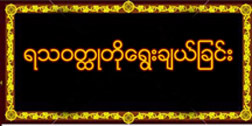Buddhist Doctrines of the Pāli Nikāyas: Analysis and Interpretation
ME 01 11-03-2011 (2:00 to 3:00)
(Class notes only)
---------------------
History of the development of pāli canon with reference to the three Buddhist Councils held in India. The first Buddhist Councils was held in Rājāgaha, the second Buddhist Councils was held at VaiSāLi and the third Buddhist Council was held at Pātaliputra. Thus the three uddhist Councils was held in India to know the evolution of Pāli canons. The current consists of the five Nikāyas, they are Dighanikāya, Majjhimanikāya, Samyuttanikāya, Aṅguttaranikāya and Khuddakanikāya.
In the Dighanikāya: there are, Sāmaññaphalasutta which are sixty two views related to the Buddhist Philosophy of Kamma Vāda. The Sāmaññaphalasutta is the second sutta in the Dighanikāya. This sutta gives the background to the King Ajātasatthu becoming a lay disciple. It starts with Ajātasatthu, in his palace, seeking advice from his ministers which samana or brahmana. Ignoring recommendations from six famous ministers (teachers). The six famous ministers are Purāna Kassapa, Makkhali Gosāla, Ajita Kesakambala, Pakudha Kaccāyana, Sañcaya Belat thaputta and Nigantha Nāṭaputta. However, of the heretical (heresy) ministers the first four ministers are nihilism, Akiriyavāda (Akamma), it is a materialism. Fifth minister is Amaravikkhepavāda and the last minister is Kiriyavāda (Kamma).
Among the parivrājakas, as it appears from this, there were founders of sects who had organized bodies of followers recognizing their leadership. Six of them are frequently referred to in the Pāli texs sanghī, ganī. ganācariya, yasassī, yasa, etc,.One who had left the household state would seek to be a convert to a sect-leader, a Ganācariya, recognizing him as his master and accepting his doctrines.
And the king turned to Jīvaka Kumārabhacca for advice. Jīvaka informed King Ajātasatthu that the Buddha was staying at Ambavana, and suggested making a trip there.
Accepting Jīvaka advice, Ajātasatthu set out from his Palace on his royal mount to meet the Buddha, together with Jīvaka, five hundred of his women on five hundred elephants and a procession of torch-bearing attendants. Later on in the sutta, we learned that the king had previously spoken to the ascetics re-commented and was not pleased with their teachings.
According to the Buddha, King Ajātasatthu will has become a stream winner, if not for the hideous crime of killing his own father King Bīvisāra. He was the son of King Bivisāra and Queen Videhi, his own son is prince Udayi bhadda.
This discourse is one of the master-pieces of the Pāli Canon. At heart, it is a comprehensive portrait of the Buddhist path of training with vivid similes. This larger portrait of the intellectual landscape of early Buddhist India is then presented in a moving narrative frame, the sad story of Kin Ajātasatthu.
(Sāmañañgato hoti) Sāmañña ‘Sa=(a),man=(ñ), c=(ñ)+a=(a)’ Sanditthika sāmaññaphala = 'in the future to attain nibbāna.’
Then, Ambattha sutta, it is the third sutta in the Deganikāya. This sutta gives the background to Ambattha, he was pleased and departed. He met Pakkharasāti with the followers of Brahmin on his way back. He reported Pakkharasāti to his encounter and conversation with the Buddha, at that time Brahman Pokkharasāti was dwelling at Ukkaṭtḥa, on a royal domain granted him by King Pasenadī of Kosala as a royal gift. The Pokkharasāti heard the news "The Samana Gotama of the Sākya clan, who went out from a Sakya family to adopt the religious life, has now arrived with great company of the brethren of his order at Ikkhānankala and is staying there.
The Buddha is the reputation that has been noised abroad: That blessed one is an Arahat. At the time Ambattha was a pupil under Pokkharasāti. He said Ambattha "Go to the Samana Gotama and find out whether the reputation, etc,… am a giver of the mystic verse; you have received them from me". Ambantha, then went to Buddha, Buddha took him their seats, but he walking, standing up about said something.
At the time, Buddha said "Ambattha, when you came here, turn your though rather to the object you had in view, this is ill bred, though he prides himself on his culture; what can this come from except.
Then, Ambattha was displeased and angry, and then he said "For the first time and the second time charge the Sākya with being menials". Buddha asked: “Ambattha, have the Sākya given you offence?” “Once, Gotama, I had to go to Kapīlavatthū". Buddha replied to him: "The Sākyas are at their own home, in Kapilavatthu. It is not fitting for you take offence at stiffing a thing, and what family do you then, Ambattha, belong to?" He answered “I am a Kanhāyana".
Buddha said: "yes, but if one was to follow up your ancient name and lineage on the parent's side, it would appear that the Sākyas, the Sākyas trace their line back to Okkāka the King. He had a slave girl called Disā, she gave birth to a black baby, so then they called devils ‘black fellows’" (Kanhe).
He was the ancestor of the Kanhāyanas. That Kanha became a mighty seer, he went into the Dekkan. There, he learnt mystic verses and returning to King Okkāka, he demanded his daughter Madda-rūpi in marriage but the king do not accept to him. He fitted an arrow to his
bow, let the arrow fly. Then, the King terrified at the lesson, given him to his daughter Maddarūpi to wife, that kanha was a mighty seer. Suppose a Brahman youth should have connection with a Kshatriya maiden, and from their intercourse a son should be born.
The Kshatriya is the best of those among this folk who put their trust in lineage. But he who is perfect in wisdom and righteousness, he is the best among gods and men".
This is the first portion for recitation in Ambattha sutta.
by Ashin Indaka (Kyone Pyaw)























0 comments:
Post a Comment